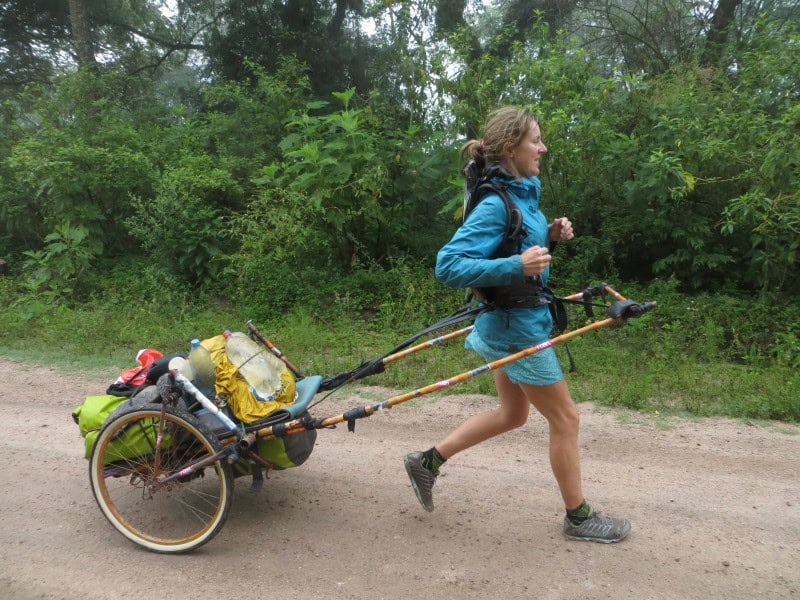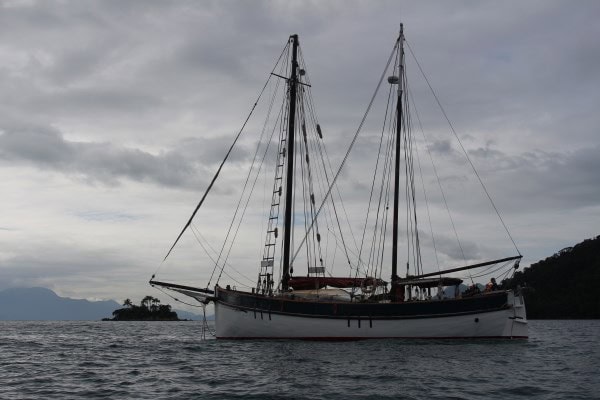Running the entire length of South America to help save wildlife simply wasn’t enough for Katharine and David Lowrie. After circumnavigating their way around the continent, Naomi Tolley catches up with the couple as they sail home from Uruguay to the UK
Just as the Olympic starting gun resonated through the streets of London in July 2012, Katharine and David Lowrie braced themselves against a blizzard at Cabo Froward, the Southernmost point of South America, and began their race to run the length of the continent.
“Unsupported, we pulled our trailer made of recycled materials, day-on-day, into the icy depths of a Patagonian winter, through tropical rain forests and hurricane-force winds, over 45-degree heat and near 100 percent Amazonian humidity, knee-deep in mud, vomiting, and attacked by swarms of insects, but determined that every step forward would pull us closer to our goal.”
That goal was to inspire environmental action and to connect globally to the communities and wildlife they met along the way. Through their interactive website and on-the-road communications, they examined and highlighted how “through our actions, we are all connected.”
“We hoped, that through the sweat, tears and determination, we would open a portal into the last wilds of South America and rekindle people’s passion for running and our amazing natural world.”
As the couple, originally from Devon, ran they made detailed recordings of the wildlife they observed, presenting to local schools and groups, promoting a greater understanding of the ecosystem services in the area.
“We hoped, that through the sweat, tears and determination, we would open a portal into the last wilds of South America and rekindle people’s passion for running and our amazing natural world,” says Katharine, speaking from a remote mooring off the South American coast.
They also raised money for Conservacion Patagonia, Birdlife International, and their partner, Armonia, a bird and wildlife charity based in Bolivia, who are conserving habitat for the critically endangered Bolivian blue-throated macaw. There are believed to be only 300 to 400 individuals left in the wild, due to habitat loss from cattle ranching and the illegal pet trade.
Some 10 million steps, 10 pairs of demolished shoes, 6,504 miles and 15 months later, they had presented to over 1,300 students in South America, raised more than £7,800 for conservation charities, recorded 453 bird species, authored 35 environmental articles, saved 6,901kg of CO2 through thedonation.org sponsorship pledges and their story had been reported around the world.
Katharine had also became the first woman to have run the length of South America and is believed to have completed the second longest run ever undertaken by a woman, while David is the first man to have run the continent ‘unsupported’ (they pulled all their food, camping, education and science equipment by cart).

Katharine pulling the cart of food, camping, education and science equipment © 5000mileproject.org
Since successfully completing their mammoth run, they have presented talks at the Royal Geographic Society, to universities, colleges and schools about their expedition and South America’s ecosystems. Katharine is also currently writing a book about their journey. But they know there is more to do.
“Around 10,000 years ago the weight of the human population was one tenth of one percent of all the Earth’s biomass, the rest was made up of wild animals,” says Katharine. “Today, humans, our pets and domestic animals make up 96 to 98 percent. Staggering. We want to show how we all absolutely depend on the natural world and how amazing it is. That with small steps we can overcome seemingly insurmountable hurdles, that time is running out, but it’s not too late protect it.”
Abandoning their running shoes and dry land, in January this year they once again boarded their boat, Lista Light, but this time with their three-month-old son. Waiting for a weather window they headed out into the Southern Atlantic from the Rio Plata, Uruguay. They are now ploughing 6,000-odd nautical-miles home to the UK, recording the sea birds and cetaceans they see en route and sending bird records to ebird.org and cetacean reports to the Whale and Dolphin Conservation Society.
“Since that ice-cold day at Cabo Froward in 2012, when we began our tip-to-toe run of the continent, our journey has been tougher than we could ever have imagined. But somehow, we got through and I feel that my dream as a little girl of doing something to protect the natural world and our joint commitment to start paying our rent for living on this extraordinary planet is starting to happen,” Katharine adds.

The couple’s boat Lista Light, which they sailed around South America and are now heading back to the UK on © 5000mileproject.org
That childhood dream, which turned into two huge expeditions, through some of the most biodiverse and climatically challenging areas on Earth, has caught the attention and support from people and organisations globally. From the World Wildlife Fund to the World Land Trust, with local people and friends also referring to them as an “inspiration to humankind”.
“It was amazing to run in the company of river dolphins, capybaras, howler monkeys and fireflies,” says David. “To feel red Amazon soil squeezing between our toes and cross the snow-clad mountains of the Andes. Now back at sea we are with our old friends the frigate birds, terns and booby birds, which we researched and wrote about in the Caribbean on our voyage south.
Like what you’re reading? We want our readers to #OwnTheMedia. Support Positive News by becoming an owner now: www.ownthemedia.org
“Soon these tropical birds will make way for their cold weather cousins and as the storm petrels and gannets arrive, we’ll know that Britain’s shores and home is finally approaching, over seven years after we last saw them from the sea.”
The couple hope to arrive home in September this year and to continue holding presentations on their expedition, as well as South American and Caribbean terrestrial and marine ecosystems.
But their main aim is to continue to remind people how much of South America’s “incredible wild lands and wildlife are threatened”.
“There are small steps we can all take to conserve them,” they say, as they head towards home, taking small steps along the way, as they have done since that blizzard at Cabo Froward in 2012.
